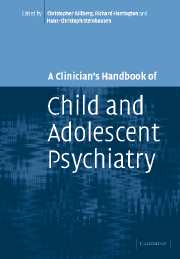Book contents
- Frontmatter
- Contents
- Preface
- List of contributors
- 1 Brain disorders
- 2 Substance use disorders
- 3 Schizophrenia and schizophrenia-like disorders
- 4 Affective disorders
- 5 Anxiety disorders
- 6 Obsessive-compulsive disorders
- 7 Adjustment disorders
- 8 Post-traumatic stress disorder
- 9 Functional somatic symptoms and somatoform disorders in children
- 10 Eating disorders: anorexia nervosa and bulimia nervosa
- 11 Sleep disorders
- 12 Personality disorders
- 13 Mental retardation/learning disability
- 14 Specific developmental disorders of speech and language
- 15 Reading and other learning disorders
- 16 Autism spectrum disorders
- 17 Hyperkinetic disorders
- 18 Conduct disorders
- 19 Elective mutism
- 20 Attachment and disorders of attachment
- 21 Tic disorders
- 22 Elimination disorders: enuresis and encopresis
- 23 Physical and sexual abuse
- 24 Gender identity disorders
- Index
- References
18 - Conduct disorders
Published online by Cambridge University Press: 06 August 2009
- Frontmatter
- Contents
- Preface
- List of contributors
- 1 Brain disorders
- 2 Substance use disorders
- 3 Schizophrenia and schizophrenia-like disorders
- 4 Affective disorders
- 5 Anxiety disorders
- 6 Obsessive-compulsive disorders
- 7 Adjustment disorders
- 8 Post-traumatic stress disorder
- 9 Functional somatic symptoms and somatoform disorders in children
- 10 Eating disorders: anorexia nervosa and bulimia nervosa
- 11 Sleep disorders
- 12 Personality disorders
- 13 Mental retardation/learning disability
- 14 Specific developmental disorders of speech and language
- 15 Reading and other learning disorders
- 16 Autism spectrum disorders
- 17 Hyperkinetic disorders
- 18 Conduct disorders
- 19 Elective mutism
- 20 Attachment and disorders of attachment
- 21 Tic disorders
- 22 Elimination disorders: enuresis and encopresis
- 23 Physical and sexual abuse
- 24 Gender identity disorders
- Index
- References
Summary
Introduction
Conduct disorder is the commonest psychiatric disorder of childhood across the world, and the commonest reason for referral to child and adolescent mental health services. Unlike most disorders, it is entirely defined in terms of the individual's relationship with other people and society. There is a persistent pattern of antisocial behaviour whereby the individual repeatedly breaks social rules and carries out aggressive acts that disturb other people. This persistent tendency typically starts young – aged 2–4 years – and carries on until at least middle age. Thus a substantial proportion of children and adolescents with conduct disorder grow up to be antisocial adults, leading impoverished and destructive lifestyles; a significant minority will develop antisocial personality disorder (psychopathy). The personal impact and cost to society is high, since many domains of living are affected, and many professionals and agencies get involved in managing the sequelae. These include police and the criminal justice system, teachers and the educational system, social workers and housing agencies, and unemployment and benefit payment offices.
Two paradoxes are apparent in society's response to affected individuals. First, despite overwhelming evidence that this is a lifelong affliction, the moment an individual wakes up on the morning of their 18th birthday, they no longer have a psychiatric problem (there is no category of conduct disorder in adulthood). Instead, they are frequently just seen as a nuisance and bad, or sometimes even plain evil.
- Type
- Chapter
- Information
- A Clinician's Handbook of Child and Adolescent Psychiatry , pp. 522 - 556Publisher: Cambridge University PressPrint publication year: 2006
References
- 2
- Cited by



